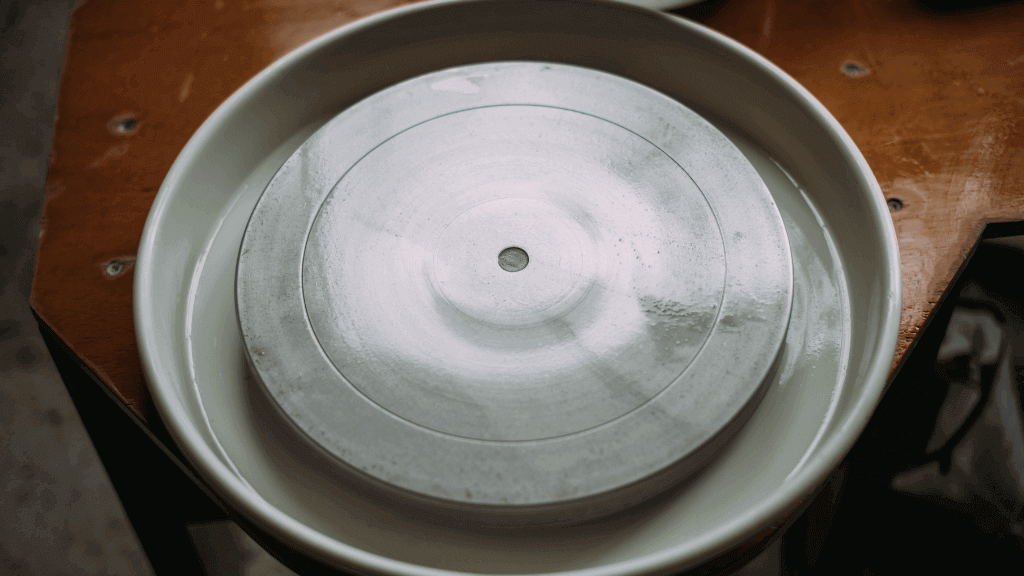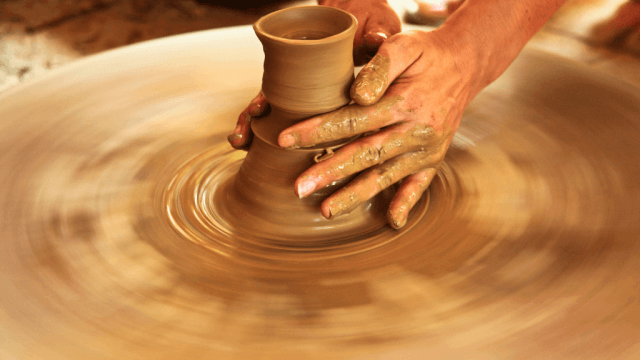To center clay on a pottery wheel, begin by securing the clay on the wheel head with consistent pressure. As the wheel rotates, apply equal force with both hands to the clay, using your fingers to balance and align the clay until it’s centered. Keep your hands steady and moist while keeping your elbows stable on your thighs for additional support. Gradually press down, then release upwards while maintaining consistent pressure to achieve a perfectly centered clay.
Preparing the Clay and Wheel Head
Before placing the clay on the wheel, wedge it to remove air bubbles and achieve a consistent texture. Clean the wheel head thoroughly and dampen it slightly. Place the clay directly in the center of the wheel head and press it firmly to secure it.
Positioning Your Body and Hands
Sit close to the wheel, placing your feet flat on the ground or the wheel’s pedal for stability. Keep your elbows anchored to your thighs to maintain steady control. For ideal hand positioning, use both hands simultaneously to apply equal pressure to the clay.
Hand Positioning for Right-Handed Potters
Place your left-hand palm-side down on the clay, fingers pointing 12 o’clock (away from your body). Position your right hand on the right side of the clay, with the fingers and thumb tips pointing inward. The inside of your right wrist should lay against your right thigh.
Hand Positioning for Left-Handed Potters
Put your right hand on the clay, palm-side down, with fingers pointing 12 o’clock (away from your body). Your left hand should be on the left side of the clay, with the fingers and thumb tips pointing inward. Rest the inside of your left wrist against your left thigh.
Centering the Clay
Start by wetting your hands and the clay, ensuring they are properly lubricated. Slowly push your left hand towards your right while applying consistent downward pressure. Simultaneously, push the clay towards the center with your right hand.
Applying Downward and Upward Pressure
Once you feel the clay is centered horizontally, press downward firmly to compact the clay using your left hand to apply equal, consistent pressure. When it reaches a cone-like shape, apply upward pressure to stretch it back out. Repeat this process until the clay becomes smooth and centered.
Mastering the Centering Technique
Centering clay on a pottery wheel requires patience and practice. With time and dedication, you’ll be able to sense when the clay is perfectly centered through subtle changes in pressure and movement. Remember, keeping your hands steady, your body properly positioned, and maintaining consistent pressure are the keys to successful centering.
Troubleshooting Common Centering Issues
While learning how to center clay, you may encounter certain challenges. Let’s look at some common issues and their solutions:
Excessive Wobbling and Shaking
If the clay is wobbling or shaking too much, try slowing down the wheel to a comfortable speed. Remember to keep your hands steady and your body positioned close to the wheel for optimal control over the clay.
Difficulty Applying Equal Pressure with Both Hands
If you’re struggling to apply equal pressure with both hands, focus on maintaining a rhythm between your hands while gently pressing the clay. Make sure your hands are wet enough to avoid friction, which may cause the clay to warp during the centering process.
Preventing Air Bubbles
Air bubbles can cause inconsistencies during the centering process and may affect the final product. To avoid this issue, wedge your clay thoroughly and ensure it’s free of air bubbles before placing it on the wheel head.
When to Stop Centering Clay
Knowing when to stop centering the clay on a pottery wheel is essential. As you press and release the clay repeatedly, you’ll start to notice less resistance. The clay will feel smooth and steady, no longer wobbling as the wheel spins. That’s when you’ll know it’s time to stop centering and move on to the next step in the pottery-making process.
Alternative Centering Methods
While the aforementioned technique is widely used for centering clay, there are alternative methods that some potters might find useful:
Two-Handed Vertical Method
In this method, position both your hands vertically on the left and right sides of the clay. Apply consistent pressure while maintaining your wrists and elbows against your thighs for steady control.
Cone-Shaped Press and Release
This technique involves coning the clay upwards and then compressing it back down multiple times. During each compression, apply pressure evenly to smooth the clay and remove any inconsistencies.
Experiment with different centering methods to find the technique that works best for you. With practice, you’ll become more confident and efficient at centering clay on a pottery wheel.
Frequently Asked Questions
We’ve compiled a list of frequently asked questions related to centering clay on a pottery wheel to help provide further guidance and tips for a successful pottery experience.
Is there a specific type of clay best for beginners?
Stoneware and earthenware clays are typically the most beginner-friendly, as they’re more forgiving and easier to work with. These clays have a good balance of plasticity and strength, making them suitable for various pottery projects.
How can I prevent my hands from slipping while centering clay?
Keep your hands and the clay adequately lubricated with water to prevent friction and slipping. If you find your hands are still slipping, consider using a sponge to maintain a proper grip on the clay. However, be cautious not to use too much water, as it can cause the clay to become too soft and difficult to work with.
How do I know if my clay is properly wedged?
You’ll know your clay is properly wedged when it has a consistent texture, free of air bubbles, and feels smooth to the touch. The process of wedging also aligns the clay particles, making it easier to work with on the pottery wheel.
Why is my clay collapsing while applying pressure during centering?
If your clay is collapsing while applying pressure, it may be overly soft or saturated with water. Try wedging the clay to remove excess moisture, and avoid using an excessive amount of water during the centering process.
What should I do when the clay becomes off-center during other steps of the pottery process?
If your clay becomes off-center during other steps, it’s essential to re-center it before continuing. Take a moment to stop the wheel, assess the issue, and gently apply pressure using your hands to re-center the clay. Remember to maintain steady control and consistent pressure throughout the process.











